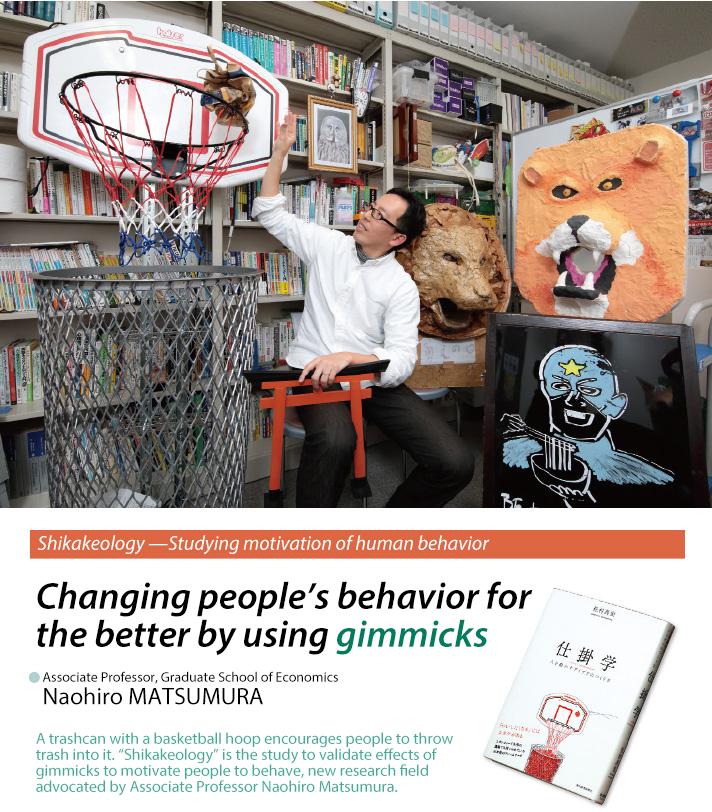
Changing people’s behavior for the better by using gimmicks
Changing People’s Behavior Solved a Problem
Associate Professor Matsumura defines a “gimmick” as “something to motivate people for the better.” He says, “When thinking of how to lower hurdles that people must deal with in daily life, I thought it would be better to change the behavior of people who think of them as hurdles not by force, but by encouraging them.”
For example, a urinal with urinal target marker to reduce undesired splash. Another example would be file folders with a diagonal lines on their spines. If you put them together in the right order, it makes a consecutive line, which makes you want to place them in that order. Yet another example would be a deterrent, such as a mini torii (a Shinto shrine’s sacred gate) placed at a fence in the alley to ward off those who would otherwise leave waste in the area.

Inspired by a tube at Tennoji Zoo
Dr. Matsumura entered the Osaka University Faculty of Engineering Science to study artificial intelligence and continued his research at The University of Tokyo. Currently, however, he teaches data analysis regarding company management at the Osaka University Graduate School of Economics.
In 2006, he hit on the idea of choosing Shikakeology as a research theme. While studying data analysis, he noticed that "most events in the world are not quantified.” He was looking for a new theme while thinking about different options, including totally changing his research theme.
At Tennoji Zoo (Tennoji-Ku, Osaka) he happened to find a telescope-like tube placed at a height of 1m, a device to encourage people to look inside. Looking through the tube, curious individuals found elephant dung there. Children were enjoying looking into it.
“‘That’s it.’ I thought. The tube was a gimmick to get people to discover elephant dung. I realized that, without having to rely on computers, by just changing people’s awareness, people can discover something that is normally unnoticed.”

Making Handai Slope a Landmark with his own Gimmick
In addition to gathering examples of various gimmicks, Dr. Matsumura himself tries various gimmicks that he made. For example, he placed basketball hoop trashcans on the university campus and hand disinfectors shaped like lion heads at Tennoji Zoo in order to collect and verify data such as usage frequency.
Moreover, he plans a race called “Ebisu Otoko Erabi (Lucky Man Run.)” Based on Nishinomiya Shrine’s ritual “Kaimon Shinji Fukuotoko Erabi,” the annual race in which men compete by sprinting from the gate to the shrine’s main hall, together with the local shopping street, he plans “Ebisu Otoko Erabi" in which men run up the “Handai Slope,” the slope leading to the Toyonaka Campus. This is also a kind of gimmick to make the Handai Slope a landmark of Osaka University by making Handai Slope accessible to local people.

Hoping that manga Shikakeology will motivate elementary school students to perform independent research
Shikakeology is expected to be applied in various fields, such as marketing. Dr. Matsumura said, “I coined the word Shikakeology and included it in the title of my book.” Shikakeology is the combination of the Japanese word ‘shikake’ for gimmick and ‘ology.’ “I want to spread the concept of shikake and its way of seeing things.”
Last year, he published Shikakegaku—Hito wo Ugokasu Aidea no Tsukurikata [Shikakeology—Creating Ideas that Motivate People] (Toyo Keizai Inc.). Following this book, he plans to publish manga Shikakeology soon so that elementary school children can use it for independent study in their summer holidays. “I want kids to think about gimmicks using their sensibilities. If possible, I want to hold a contest. I hope they will become interested in study through the process of finding problems around them and thinking about gimmicks to solve them,” said Dr. Matsumura, searching for gimmicks for spreading Shikakeology.
Naohiro MATSUMURA
1998 Graduated from the Department of Systems Engineering, School of Engineering Science, Osaka University.
2003 Completed doctoral program at the School of Engineering, The University of Tokyo (Doctor of Engineering).
2004 Lecturer at the Graduate School of Economics, Osaka University. Current position as Associate Professor, Graduate School of Economics, Osaka University from 2007.
2012-2013 Visiting Scholar at Stanford University.